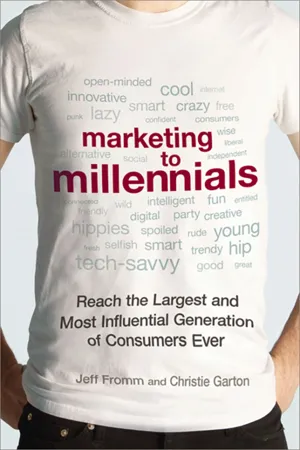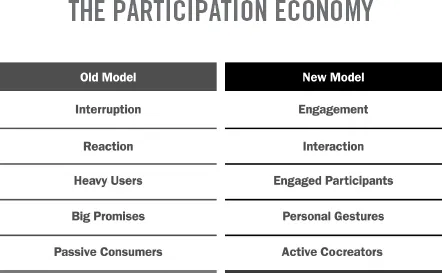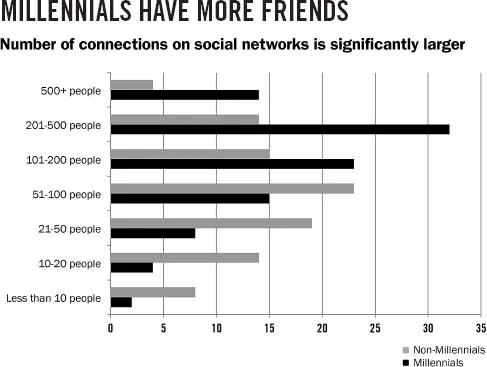Meet Janelle, age 27.
Stretched across the hood of a Ford Fiesta in a loving embrace, her Facebook photo could easily be an ad for Ford.
Simple as that.
Well, actually, it’s not so simple. For a company like Ford that wants to remain relevant, understanding Janelle’s very public display of affection couldn’t be more crucial.
A decade ago, a consumer of Janelle’s age might have simply shared her affinity for Ford with her closest group of friends, and maybe one or two would be tempted to take a test drive. But thanks to digital and social tools like Facebook, her photo can now be seen far and wide. Janelle’s power to influence others is exponentially higher today than it would have been in the past.
The Participation Economy
Not willing to be passive consumers any longer, this generation wants to actively participate, cocreate, and, most important, be included as partners in the brands they love. Often, the cocreation process begins with the product or service design, includes the customer journey or shopping experience, and is more easily seen in the marketing and social media space closer to the end of the marketing cycle. In fact, one could argue that functional and emotional benefits alone will not be enough for your brand to thrive with this generation since Millennial brand fans feel they have a shared interest in the brand’s success.
Welcome to the participation economy.
Former Medtronic CEO and Harvard Business School professor Bill George provided a good summary of the participation economy concept back in 2009, when it was in its more nascent stage: “People are their own medium, their own creation. You have to let them in, [l]et consumers move your ideas along. They want to interact. Measure ‘Return on Involvement’ not ‘Return on Investment.’ ”1
It’s a huge shift that youth-focused brands like MTV and Frito-Lay (which you’ll hear more about later) were some of the first to notice and address this in their strategy process.
But just a few short years later, the participation economy has arrived at the doorstep of all companies, fundamentally impacting not only their marketing tactics but how they do business as well, and we are only just beginning to understand its full implications.
The Old Framework vs. the Participation Framework
In the past, consumers were rarely part of the product development and marketing process. Outside of focus groups done in person or by phone, instantaneous feedback channels like Facebook, Twitter, and crowdsourced ratings and review websites like Yelp didn’t exist. (See Figure 1-1.)
Driven by advances in digital and mobile technology, consumers of all ages can participate in these once closed-door processes, and many are accepting, if not demanding, the invitation. For Millennials, it’s almost an expectation that companies should want to seek their opinion.
In one successful instance, craft beer brewer Samuel Adams took an unprecedented step by letting Facebook fans create a new brew. To crowdsource ideas, the company used an app called the CrowdCraft Project on Facebook, helping to determine the beer’s color, clarity, body, hops, and malt. The ideas that garnered the most votes were incorporated into the beer, which was served at the popular South by Southwest Festival in Austin, Texas, and at the Samuel Adams Boston Brewery in Boston, Massachusetts.
Source: Barkley, The Boston Consulting Group, and Service Management Group, “American Millennials: Deciphering the Enigma Generation,” September 2011.
Figure 1-1 An overview of the participation economy.
For an example from the tech industry, consider how the Android line of cell phones demonstrated that it’s good for business to include consumers in the product development process. Android’s mobile operating system is the polar opposite of Apple’s iOS. Indeed, Android uses an open-source network that allows users to improve the system by building add-ons and apps.2 This endeavor, launched in collaboration with Google, allows for cocreation, innovation, and consumer feedback. The goal is to create a network where everyone can contribute to making the best product possible. Talk about valuing the customer’s opinion!
On the other hand, Apple’s closed and proprietary approach draws criticism from digital rights advocates such as the Electronic Frontier Foundation (EFF) for creating a “crystal prison” for developers and end users. At issue are restrictions imposed by the design of iOS, namely: “digital rights management (DRM) intended to lock purchased media to Apple’s platform, the development model (requiring a yearly subscription to distribute apps developed for the iOS), the centralized approval process for apps, as well as Apple’s general control and lockdown of the platform itself,” according to Wikipedia.3
“This issue doesn’t come as much of a surprise to anyone who has become involved with Apple products,” Simon Sage, blogger and editor-at-large of Mobile Nations, wrote. “It’s hard not to get an iPhone and Mac and not know that from here on in, you’re expected to do things The Apple Way.”4
The end result? An inferior product, says none other than Steve Wozniak, cofounder of Apple, according to the EFF.5 “[N]o place, and no system, can be perfect if it denies its citizens the freedom to change it, or the freedom to leave,” says an EFF report.6
It can also impact sales. In late 2011, iOS accounted for 60 percent of the market share for smartphones and tablet computers. However by mid-2012, iOS had slipped to just 16.9 percent and Android had taken over with 68.1 percent global share.7 While a direct link between Android’s open network approach and increasing market share is a bit of a stretch, it is undeniably a contributing factor.
Certainly, we are witnessing an increasing number of brands turning to social media to tap consumer insights and engage fans of all ages, but where we are really seeing the most engagement—the participation economy at play—is with Millennials.
So what got us here? Although non-Millennial generations value personal connection, our study found that Millennials use technology to connect with a greater number of people, more frequently, and in real time. Not only are they using social media platforms more than non-Millennials, they maintain significantly larger networks and influence.
Indeed, 46 percent of Millennial survey respondents reported having 200 or more Facebook “friends,” compared to 19 percent of non-Millennials, as you can see in Figure 1-2.
Source: Barkley, The Boston Consulting Group, and Service Management Group, “American Millennials: Deciphering the Enigma Generation,” September 2011.
Figure 1-2 Millennials have more online connections.
It’s not just about the size of their network. Millennials report that they gain a psychological boost when engaging with their online friends. This is a significant shift between generations. In fact, Millennials reported that they feel they are missing out when they are not up to date on social media chatter, and they feel validated when the community “likes” their posts—especially when they are the first to review a product or service or give advice to a friend on a purchase decision. As shown in Figure 1-3, Millennials overwhelmingly agree (47 percent vs. 28 percent) that their lives feel richer when they’re connected to more people through social media connections.
Given these findings, it comes as no surprise that Millennials are also off the chart when it comes to their willingness to give companies feedback. In fact, they find increased brand value and preference when they provide marketing and strategy professionals with their views.
“Millennials are a very open generation, and a great resource for brands, as cocreation is second nature for them,” says Jacqueline Anderson, director of product development at J.D. Power and Associates and former Millennial-focused senior analyst at Forrester Research. “If you’re facing a challenge as a brand, reach out.”
In the apparel industry, social shopping site Krush is another example of a company that is effectively tapping consumer insight. In this case, it’s to boost the bottom line. Krush, a Boston-based start-up, addresses the age-old dilemma of retailers losing millions of dollars on products that never sell because they don’t have a clue what consumers want. They do this by offering retail brands a platform where they can go directly to their key site users, ages 15 to 30, with “Exclusive SneakPeeks” or previews of upcoming lines in order to gauge how successful they’ll be when they hit the stores.
These consumers are encouraged not to hold back on their critiques but, instead, to be vocal about their opinions, setting the trends rather than following them.8 At the end of a Sneak-Peek, each Krush brand receives an in-depth report that summarizes all consumer feedback including which demographics prefer which items—and at which locations. Not only i...



